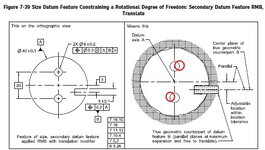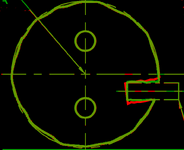greenimi,
So here is why the secondary datum feature in fig 7-39 provides clocking:
The short and trivial answer is because it constrains a rotational degree of freedom around a datum axis and that is what by convention called clocking. You could argue that it may provide some extra rotation of the part until the secondary TGC is envolved relative to the fixed-at-basic scenario, but once the relationship of the part to the secondary datum has been established, that rotation is no longer available nevertheless.
A more elaborated explanation may be in terms of how the datum reference frame is established relative to the part. Consider the cylindrical primary datum feature constraining 4 degrees of freedom. It provides a datum axis and two planes of the DRF intersecting at the axis, but those planes are free to rotate like fan blades around it. That is, until the secondary datum (center plane, in this case) is brought in. Then, the secondary datum provides a direction for one of the DRF planes to be parallel to, and for the other one to be normal to. That's when you can say that the part has a relationship to the the X and Y axes, and the holes need to conform to a pattern of 2 tolerance zones or virtual condition boundaries that is not only centered but also vertical relative to the established coordinate system.


